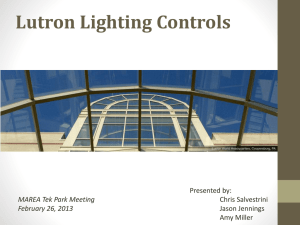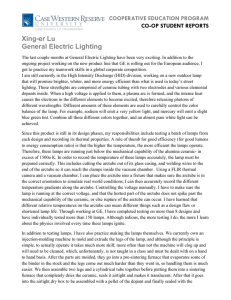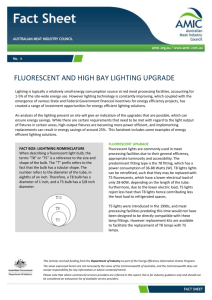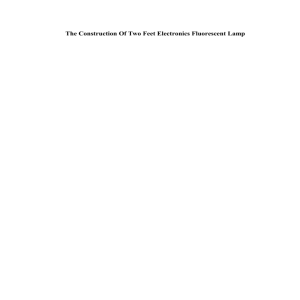E N E R G Y ... F S
advertisement
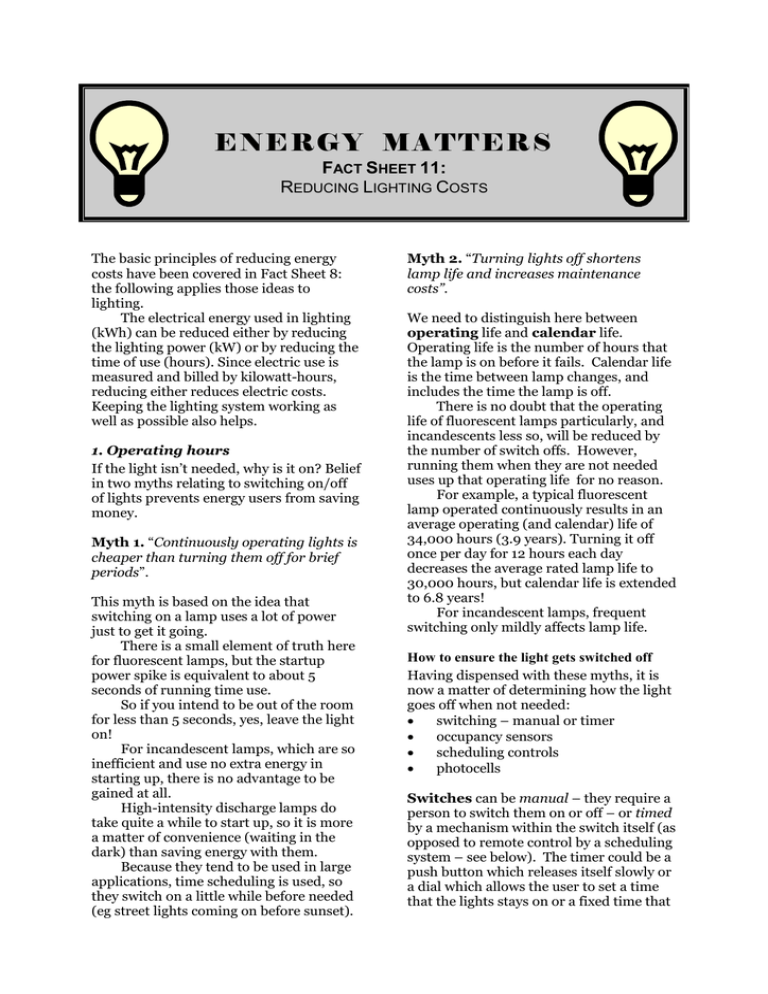
E NE RG Y MAT TER S FACT SHEET 11: REDUCING LIGHTING COSTS The basic principles of reducing energy costs have been covered in Fact Sheet 8: the following applies those ideas to lighting. The electrical energy used in lighting (kWh) can be reduced either by reducing the lighting power (kW) or by reducing the time of use (hours). Since electric use is measured and billed by kilowatt-hours, reducing either reduces electric costs. Keeping the lighting system working as well as possible also helps. 1. Operating hours If the light isn’t needed, why is it on? Belief in two myths relating to switching on/off of lights prevents energy users from saving money. Myth 1. “Continuously operating lights is cheaper than turning them off for brief periods”. This myth is based on the idea that switching on a lamp uses a lot of power just to get it going. There is a small element of truth here for fluorescent lamps, but the startup power spike is equivalent to about 5 seconds of running time use. So if you intend to be out of the room for less than 5 seconds, yes, leave the light on! For incandescent lamps, which are so inefficient and use no extra energy in starting up, there is no advantage to be gained at all. High-intensity discharge lamps do take quite a while to start up, so it is more a matter of convenience (waiting in the dark) than saving energy with them. Because they tend to be used in large applications, time scheduling is used, so they switch on a little while before needed (eg street lights coming on before sunset). Myth 2. “Turning lights off shortens lamp life and increases maintenance costs”. We need to distinguish here between operating life and calendar life. Operating life is the number of hours that the lamp is on before it fails. Calendar life is the time between lamp changes, and includes the time the lamp is off. There is no doubt that the operating life of fluorescent lamps particularly, and incandescents less so, will be reduced by the number of switch offs. However, running them when they are not needed uses up that operating life for no reason. For example, a typical fluorescent lamp operated continuously results in an average operating (and calendar) life of 34,000 hours (3.9 years). Turning it off once per day for 12 hours each day decreases the average rated lamp life to 30,000 hours, but calendar life is extended to 6.8 years! For incandescent lamps, frequent switching only mildly affects lamp life. How to ensure the light gets switched off Having dispensed with these myths, it is now a matter of determining how the light goes off when not needed: • switching – manual or timer • occupancy sensors • scheduling controls • photocells Switches can be manual – they require a person to switch them on or off – or timed by a mechanism within the switch itself (as opposed to remote control by a scheduling system – see below). The timer could be a push button which releases itself slowly or a dial which allows the user to set a time that the lights stays on or a fixed time that the light stays on when the switch is activated. Occupancy recognition is the strategy applied to intermittently occupied areas to turn lights on when people are present and automatically turn lights off after the room is unoccupied (eg you might have an outside light near your garage or backdoor which comes on automatically when you go near it, and then goes off a short time later). The two principal technologies used for occupancy sensors are passive infrared (PIR) and ultrasonic. Scheduling is the control strategy employed to activate, extinguish, or adjust lighting according to a predetermined schedule and is best suited for facilities where certain things happen at certain times. Time clocks are the easiest way to implement scheduling strategies. When timers are used to turn off lights in occupied areas, they should have a feature that warns occupants when lights are going to be turned off so occupants can extend the on time. EXERCISE 1 What aspects should be available for programming in an ideal light scheduling system? 2. Lighting Power The simplest method of reducing lighting power is design, either before construction or as a part of alighting audit (see next section). Lighting using the minimum power for safe and effective functions within the space being lit is used. If a 40W lamp will do, then a 60W lamp is only wasting energy. More sophisticated systems which including control mechanisms to provide continuous control over lighting power include: • dimmer controls • daylight harvesting – using light sensors in conjunction with dimmer controls • lumen depreciation compensation – take into account the age and cleanliness of the light, adjusting the output accordingly Ballasts typically have a long life; therefore, replacing ballasts that are still working can be one of the most costeffective energy improvements. Older ballasts are incompatible with some new lamps and will result in a decrease in lamp life of up to 50 percent. 3. Maintenance Maintenance means replacement of faulty or blown lamps and cleaning of the optical systems. EXERCISE 2 How does maintenance of lighting systems impact on energy saving? Photocells are light-activated switches used to turn off lights when daylight is adequate for safety and task performance. They are made of cadmium-sulfide cells that reduce sensitivity over time. A delay feature prevents rapid cycling during cloudy days. Energy Matters 11. Reducing Lighting Costs Page 2 of 2

